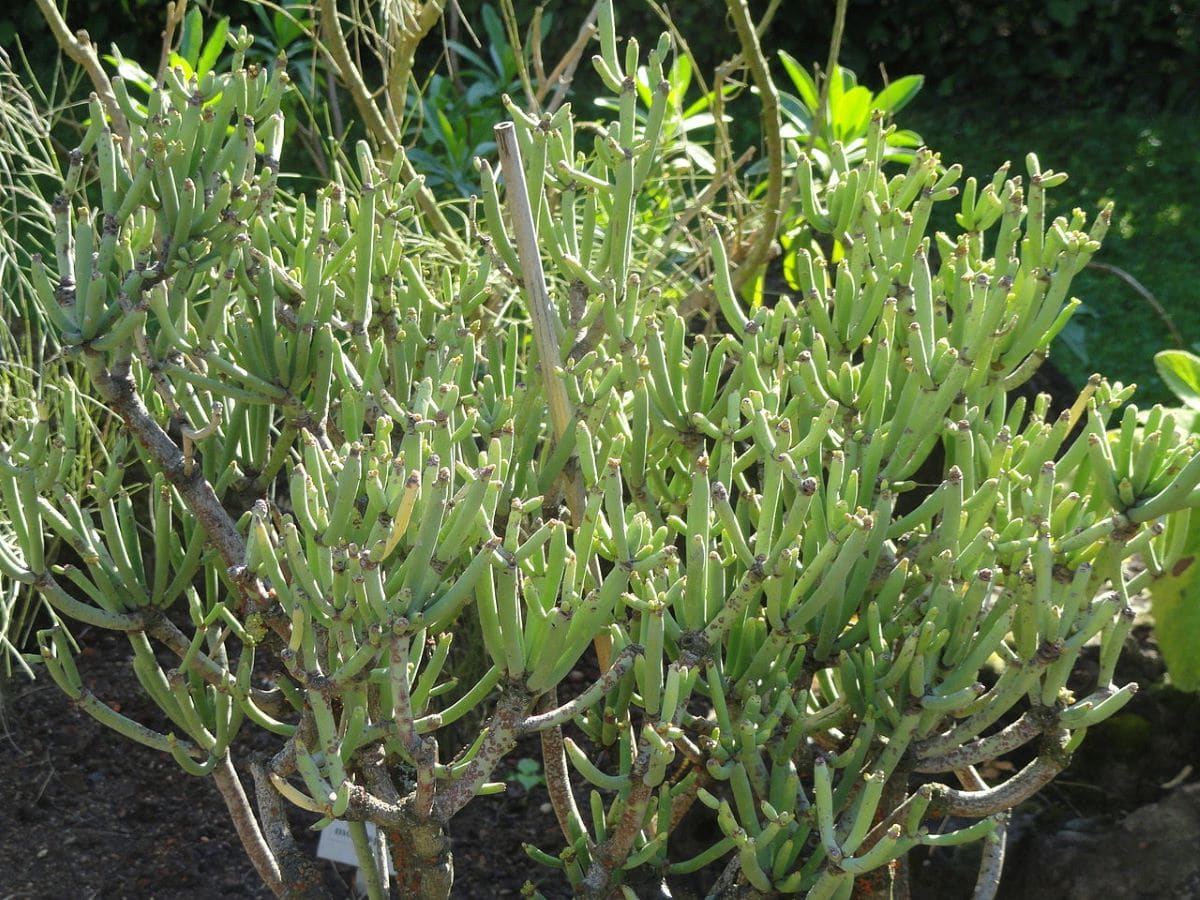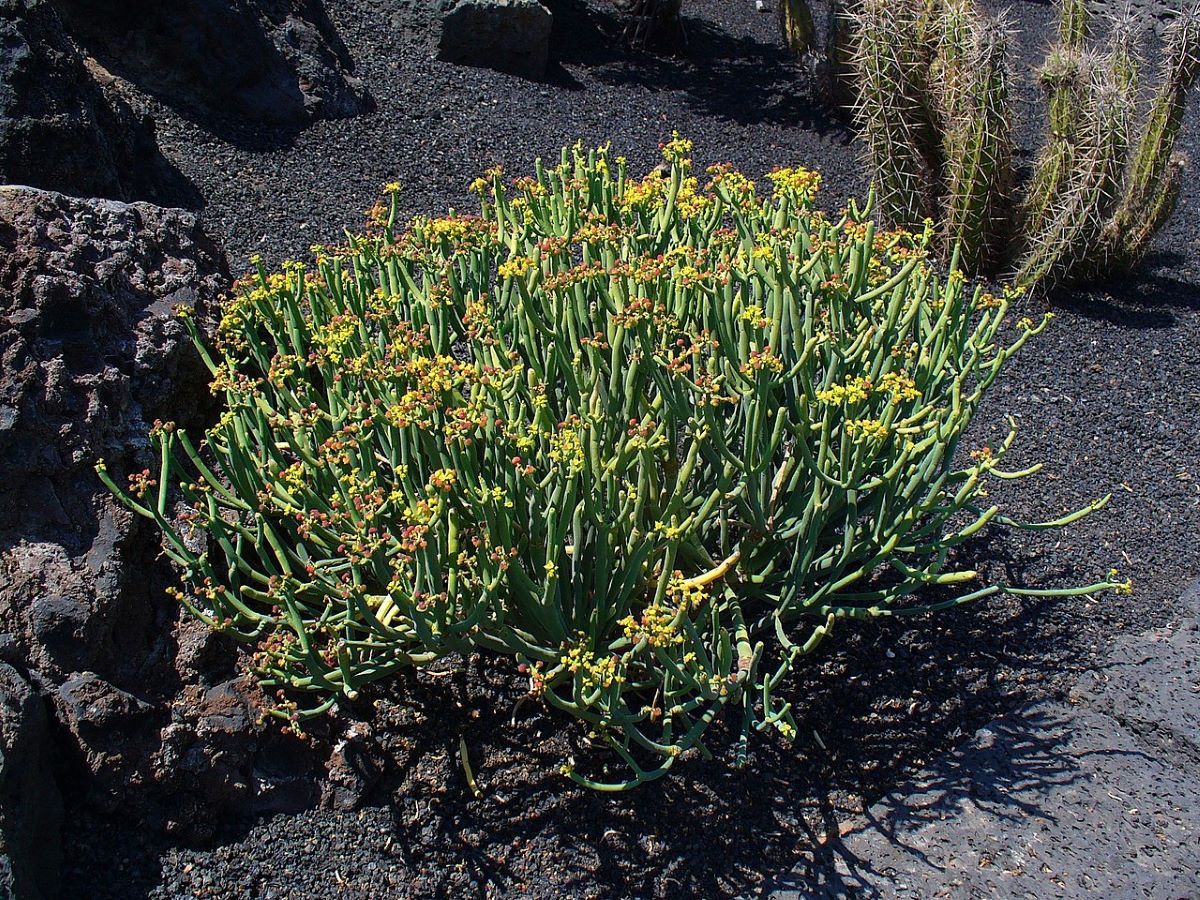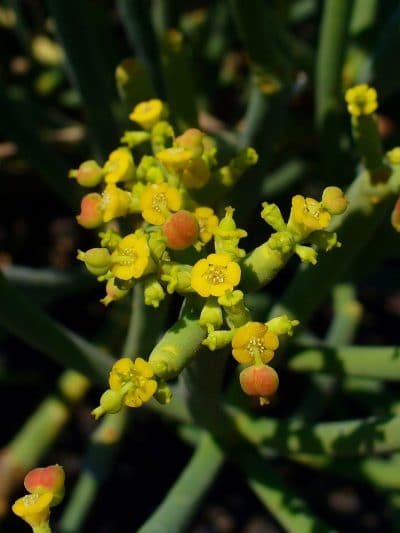
La Euphorbia aphylla It is a shrub that can be grown both in a large pot and in the ground. It grows slowly, and although it does not have as beautiful flowers as rose bushes, for example, it is a plant that can be an excellent option to grow in a place where temperatures become very high in summer and where, in addition, it rains little. .
So we are not going to extend further with the introduction, because we really want to tell you everything you need to know about it, the Euphorbia aphylla.
Origin and characteristics of Euphorbia aphylla

Image - Wikimedia / Olo72
Our protagonist is a shrubby plant endemic to the Canary Islands belonging to the genus euphorbia. It can reach a height of 50 centimeters, and branches from a short distance from the ground. It has succulent stems, but no leaves sprout from them. The florets sprout from the top of the stems, are yellow, and are grouped in inflorescences.
As for its growth rate, it is not one of the fastest plants, but we can see that it grows around 5 centimeters each season. This, added to its high resistance to drought, makes it very interesting to grow it. But yes, it is important to note that, like all euphoria, it also contains latex inside. This, if it comes into contact with the skin, causes irritation and itching.
How do you take care of yourself?
Take care of a Euphorbia aphylla It's easy, as you only need our attention from time to time. In fact, problems can appear if we pamper her excessively; that is, if we water it very often or if we pay it more than necessary. For this reason, and in order to always keep it in good health, we will see below how to take care of it:
Location
It is a plant that it must be in a sunny place, since in places where there is not much light it tends to grow etiolate. This means that its branches are longer than necessary, weakening, in the direction of the most powerful light source that is in the place where it is.
You do not have to worry about its roots since they are not invasive, but we do recommend that, if you are going to put it on the ground, you plant it a meter or so from the wall. In this way, it will be able to grow and develop with total freedom.
Soil or substrate
- Garden: the Euphorbia aphylla grows on light soils, which do not easily puddle. Therefore, if the one in the garden is very compact, the ideal would be to dig a hole of about 50 x 50 centimeters at least, and fill it with a mixture of peat moss with pumice or perlite in equal parts.
- Flower pot: if you are going to have it in a pot, it is advisable to plant it with light substrates, such as black peat mixed with perlite in equal parts, or soil for succulents (for sale here).
Irrigation

Image - Wikimedia / H. Zell
If we talk about irrigation, it must be scarce. It is a plant that, although it is capable of withstanding drought once established in a place, excess water will rot the roots. For this reason, it is important that irrigation is controlled, watering only when the soil has dried. Of course: every time it touches, we have to add water to said soil, or substrate if it is in a pot, and always in the late afternoon. This will give you more time to hydrate.
On the other hand, if you are going to grow it in a pot, you do not have to put a plate under it, because every time you water the water that has not been absorbed, it will accumulate in that plate. Consequently, the roots will be in contact with it, something that could be counterproductive, since they could literally drown. So to avoid this, it is best to let the water run out of the drainage holes and onto the ground. If you want to put a plate on it, remember to drain it after watering.
Subscriber
La Euphorbia aphylla is a plant that fertilizing is recommended if planted in a pot in spring and summer. For this, liquid fertilizers or fertilizers will be used, such as a specific one for succulents (for sale here). The instructions for use must be followed, otherwise we are going to run the risk of adding more quantity than would be adequate, and this, rather than helping it to grow more, would do just the opposite: damage its root system, slowing its growth.
Multiplication
Multiply by stem cuttings during spring. To do this, one is cut with a previously disinfected hand saw, and cut. It is then planted in a pot with, for example, substrate for succulents, watered and placed in semi-shade. To increase the chances of success, the base can be impregnated with rooting hormones (on sale here) before planting, but it is not essential.
In a matter of a couple of weeks it will begin to emit its roots, although we will have to leave it in that pot until it has rooted well; that is, until we see that the roots begin to appear through the holes in the pot.
Rusticity
Withstands very mild frosts of up to -3ºC, and provided that they are punctual and of short duration.

Image - Wikimedia / H. Zell
What did you think of Euphorbia aphylla?